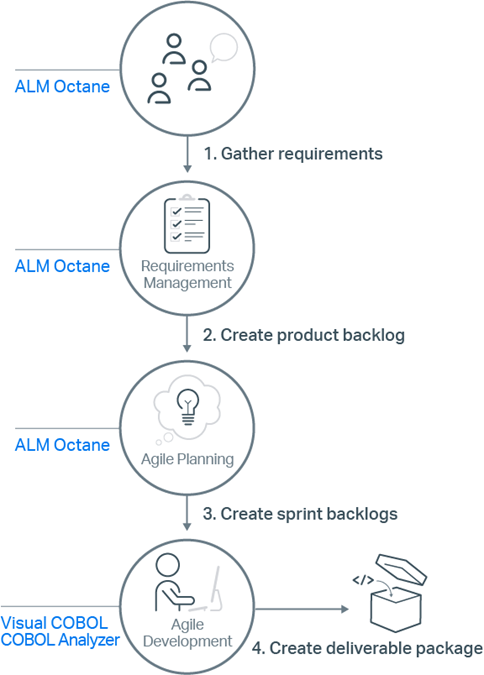Agile Development and Micro Focus Development Tools
The sections Introduction to Agile Methods and Agile Development Workflow introduce the idea of Agile software development and summarize how Agile development works as a process. This section looks at the Agile development process and shows how different products available from Micro Focus fit into and add value to that process.
The diagram below shows the process presented in the topic Agile Development Workflow but has been updated to indicate which Micro Focus products are appropriate at different parts of the process. Although this diagram refers to Micro Focus products, the process described does not require the use of Micro Focus products, so if you are already using a third-party product for one part of the process you can continue to work with that and use Micro Focus products to integrate with it.

where the numbered steps are as follows:
- Use
Micro Focus ALM Octane for requirements management.
The Requirements module provides you with a central repository for documenting and tracking all aspects of your project, from conception to delivery. This can include business goals, customer requests, functional requirements, or any other requirements whose approval and progress you want to track.
- Use
Micro Focus ALM Octane to create a product backlog comprising epics, features and stories.
The product backlog provides you the ability to rank development items and plan development cycles, and the hierarchy of epics, features and stories describes the work required to complete your project. You can also push requirements from the Requirements module into the backlog to be ranked and prioritized against other work.
- Use
Micro Focus ALM Octane to create sprints and releases, which you use to define and track the work on the product backlog that will be
done by the development team.
During each sprint, developers take items from the backlog, work on them, and complete them by the end of the sprint. At the end of each sprint, the items on that sprint's backlog must be completed; not just coded, but tested, documented, and integrated into a working product that could be deployed (if required).
- Use
Visual COBOL to produce a deliverable product package, if required.
When using Visual COBOL, developers can use the complete array of analysis, intelligence and reporting tools provided by Enterprise Analyzer to quickly gain a full understanding of the applications they are working on. Integration between ALM Octane and Visual COBOL means developers can easily work on code changes and keep ALM Octane's status information up to date at the same time.
At the end of a sprint you return to the Agile planning stage to create the next sprint backlog. At the end of the project you return to the requirements gathering stage to create the new product backlog.
The following list gives a very brief summary of each of the Micro Focus products that play a part in the Agile development process:
- ALM Octane (Backlog and Team Backlog modules)
Micro Focus ALM Octane is the enterprise-class planning and tracking solution for Agile software projects.
ALM Octane is a web-based application lifecycle management platform that enables teams to collaborate easily, manage the product delivery pipeline, and visualize the impact of changes.
ALM Octane has been designed to integrate easily with Visual COBOL, as well as with third-party tools within the DevOps toolchain.
- ALM Octane (Requirements module)
Micro Focus ALM Octane enables teams to create requirements in a much more collaborative and flexible way in comparison to other requirements management tools.
Requirements can be high-level descriptions or formal documentation for your release, depending on your development methodology.
- COBOL Analyzer
Micro Focus COBOL Analyzer is powerful code analysis and visualization toolset, designed to address the challenges of working with large-scale, complex applications.
COBOL Analyzer enables you to quickly gain a thorough understanding of your applications, meaning that you reduce the amount of time it takes you to make your changes and you can have more confidence that your changes have the desired effect and do not introduce any new issues.
You can also use COBOL Analyzer to run queries to determine if your code conforms to your in-house standards. Any code that does not conform to your standards can be flagged as an error following a commit or during the build process.
- Visual COBOL
Micro Focus Visual COBOL is the next-generation solution for COBOL application development and deployment. It enables you to modernize COBOL systems using Visual Studio and Eclipse as well as deploy COBOL applications and services to new platforms, including .NET, JVM, and the cloud.
The following features of Visual COBOL make it an invaluable part of the Agile development process:
- Integration with SCC-compliant source code control systems to enable you to work seamlessly with your source code.
- Integration into Visual Studio provides useful debugging features such as colorization, IntelliSense, error flagging, and intelligent copybook handling to enable you to quickly track down any issues, establish their cause, and make your edits.
- The Micro Focus Unit Testing Framework, an xUnit-style testing framework, includes much of the architecture you would expect of an xUnit framework, enabling you to create, compile, run, and debug unit tests from either the command line or the Visual COBOL IDE.
- Core dump debugging. When an application crashes you can arrange for its state to be saved to disk, in a core dump file, which can indicate where the error occurred in the source code, the contents of memory at the time of the error, and the values of any variables and expressions set at the time. You can then use the core dump file to help debug the problems.
- Remote debugging enables you to debug programs that are running on a different computer from the one on which you are using.
- The Consolidated Tracing Facility (CTF) produces detailed diagnostic information that can be invaluable in diagnosing problems when you can't easily attach a debugger.